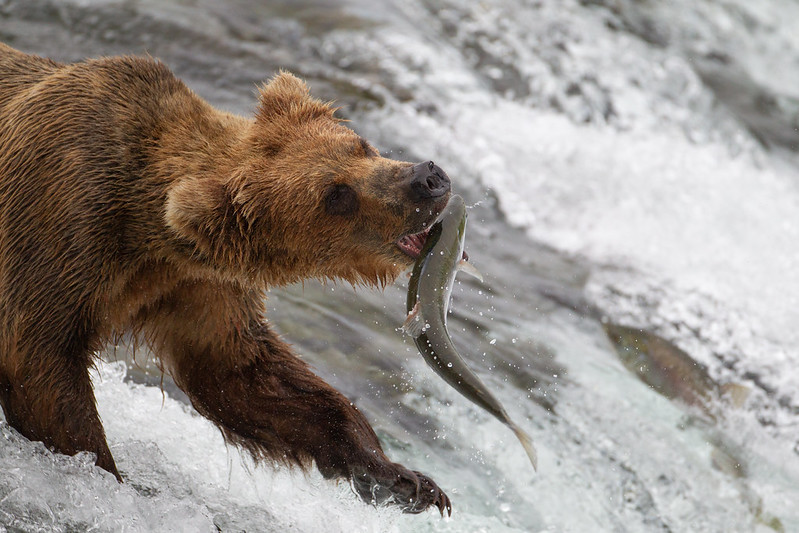Persistent Pollutants

Credit: Peter Pearsall/USFWS
The purpose of Air Quality Awareness Week is to bring attention to air pollutants that damage human health and environmental health.
Background
Many human-made substances can be lifted into the air by evaporation, smoke, or wind. Most of these substances break down into harmless chemicals within minutes, hours, or days. However, some last for years or decades. These pollutants deposit onto public lands in very small amounts and can also affect wildlife health at very low concentrations. Three persistent air pollutants are: mercury, PFAS, and microplastics.
Mercury is released into the air from burning coal and other industrial processes. Mercury in the air can deposit on plants, soil, and waters, where it is transformed from inorganic forms into toxic methylmercury and enters food chains. Methylmercury moves up the food chain and becomes more highly concentrated with each step. As a result, predators can have concentrations of mercury much higher than prey species or plants in the same environment. Mercury can affect behavior and reproduction in fish, birds, and mammals. Many waterbodies have fishing advisories related to mercury because fish with high mercury levels can affect the health of humans who eat them.
PFAS (per- and polyfluoroalkyl substances) are a class of approximately 1,000 different chemicals widely used since the 1940s. These chemicals contain carbon-fluorine bonds which are extremely stable, don’t break down in nature, and have led to the nickname for PFAS as ‘forever chemicals.’ The effects of PFAS vary with their chemical structures, but some of these chemicals affect the human endocrine system, and can change development, metabolism, reproduction, and response to disease. There is still a lot to learn about how chemicals in the PFAS class move through the environment and what their health effects will be. People who fish on public lands should check with land managers or the state to see if there are PFAS fishing advisories for the waterbodies where they fish.
Microplastics are pieces of plastic smaller than the width of a pencil (<5 mm). The 2019 discovery that smaller microplastics can be carried by air and rain into national parks, forests, and wildlife refuges was an unpleasant surprise for air quality scientists. It’s not clear yet what effects microplastics will have on the health of living things, but research in the ocean suggests microplastics can disrupt feeding patterns of animals. Current research hopes to identify the sources of microplastics and to determine whether microplastics harm living things in streams, rivers, lakes, and the ocean.
Persistent Pollutant Resources to Share:
Mercury in the environment from NADP: https://nadp.slh.wisc.edu/networks/mercury-deposition-network/
Dragonfly Mercury Project, a national project for monitoring mercury in wildlife focused on national parks: https://wim.usgs.gov/geonarrative/dmp/
EPA’s plain-language page on PFAS: https://www.epa.gov/pfas/pfas-explained
National Wildlife Federation article on PFAS in fish: https://blog.nwf.org/2021/07/pfas-are-contaminating-our-fish-what-this-means-and-what-we-should-do-about-it/
An audio, written, and video story from Canadian Broadcasting Commission featuring Janice Brahney describing her microplastics research: https://www.cbc.ca/radio/quirks/apr-17-mother-ants-shrinking-brains-boreal-forest-tree-shifts-finding-a-new-blue-and-more-1.5987696/tonnes-of-microplastic-are-soaring-into-the-atmosphere-from-roads-oceans-and-fields-1.5987705
US Fish and Wildlife Service has an article about how plastics affect marine wildlife, and what you can do to help: https://www.fws.gov/story/oceans-trash
Suggested Social Media Posts:
Facebook: States issue fishing advisories to protect humans from persistent chemicals in fish. Where do those persistent chemicals come from? Some of the mercury and contaminants are carried by rain and airborne dust into our public lands.
Link to your local MDN site if there’s one nearby, or link to NWF article on PFAS
Dr. Janice Brahney estimates that more than 1,000 tons of microplastics are being deposited from the air into Western protected areas. For reference, 1,000 tons is the weight of
40 male humpback whales, OR
28 female humpback whales, OR
4,545 large female grizzly bears, OR
2,777 large male grizzly bears, OR
1,428 large moose.
